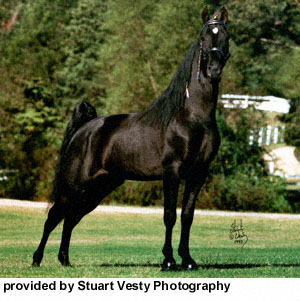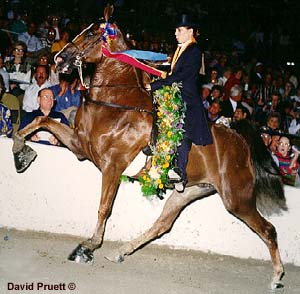

Tennessee Walking Horse


Introduction: Exhibiting great style and flare, this breed is both a wonderful sight to see and a charming ride. If you have any comments or suggestions, please click here.
Names: Tennessee Walker, Walker, Tennessee Walking Horse, Walking Horse. I may use both of the shorter names at times.
Origin: In 1935, just
yesterday as breeds go, the official registry of the Tennessee Walking Horse
Breeder's Association was formed. Sixty thousand entries have been made
since then (1974), a phenomenal show of popularity by the horse some call
"the gentleman of equines." (Something I read said the Walker is
from Tennessee and Louisiana.) The Tennessee Walker came about
because plantation owners needed a comfortable mount for long days in
the saddle.
USA, Tennessee. All Tennessee Walking Horses are
registered with the Tennessee Walking Horse Breeders' Association.
First recognized as an independent breed in 1935, this horse was developed by
crossing the old Plantation Horse of the first settlers with Thoroughbreds,
Trotters, Pacers, etc.
Breeding: Tennessee Walking Horses developed over a period of about a century and a half, mainly in the Middle Basin of Tennessee. The horses that carried settlers into this region from Virginia and the Carolinas were mostly pacers of Canadian and Narragansett bloodlines. Easy-gaited and sure-footed, they were ideal for plantation and road work. With these animals as base stock, Tennessee breeders worked toward developing a type of horse with a loose and speedy walk. The lush country, with its rich mineral soil, favored the breeding of fine horses. Crosses were made with many breeds: Arabian, Thoroughbred, Morgan, and the closely-related Saddle Horse. By the 1880's, the distinguishing characteristic of the "plantation walkers"--their running walk--was fixed. Their appearance, however, remained highly variable. The horse that would change this situation was foaled in 1886 in Lexington, Kentucky. This was Black Allan (see Profiles). As his descendants multiplied, the characteristics of the breed were stabilized.
Description: The American Saddle Horse and the Tennessee Walking Horse had similar origins and retain many points of similarity. However, the Walker has acquired his own distinct characteristics. His whole appearance bespeaks an animal of both style and substance.
Action: Unusually long stride in walk. Trotting and galloping ability.
Body: Compact, with rounded barrel. Neck is shorter than the Saddler's and not so haughtily arched; strong, muscular, arched and carried upright. Short, strong back. Well-sprung ribs, massive loins. Long, well-muscled quarters with tail carried high (usually induced by an operation). Long, sloped, muscular shoulders. Ample depth and breadth of chest. Stands covering a lot of ground. Hindquarters rounded, powerful, muscular.
Color: The color range is broad; Walkers may be either black (the most desirable color for show), chestnut, roan, white, brown, bay, gray, or gold. All solid colors. Most have some white markings; the roans are sometimes well splashed with white.
Hair: Mane and tail very long and full, usually worn loose. Very high tail set.
Head: If not classic, is broad-skulled, with a sensitive, worldly-wise expression that results from the breed's characteristic eye, which has a sloping and wrinkled upper lid. Medium-sized, with a straight profile and longish ears. Relatively refined with intelligent eyes, the upper lid showing a tendency to droop. Usually slightly Roman-nosed.
Legs: Straight, clean legs. Rather weak hind legs (hocks, cannons). Long pasterns. Strong bones.
Size: 15.2-16 hands. Standing between 15 and 16 hands and weighing up to 1,200 pounds. 15.2 to 16.2 hands.
Temperament: Probably
it is the Tennessee Walker's temperament that has earned him so many friends
throughout the U.S. Patient and amiable, he is the safe choice for the
small home stable, especially where chores such as feeding and grooming are to
be done by a youngster.
Very intelligent. Friendly and good-natured.
Features: Claimed to be the most comfortable ride in the world, the
Tennessee Walker is famous for its unique gait. The
specialty of this breed is the running walk, a gait so smooth that it's possible
for a rider to hold a glass of water without spilling a drop. Head nods with each step.
Tennessee Walking Horses are three-gaited, moving at a walk,
running walk, and canter. Though supremely comfortable in all three, it is
the running walk for which the horse is most highly valued. The pleasure
Walker glides along in this four-beat gait at perhaps eight miles an hour.
Show Walkers are trained for greater speed. Analyzing the gait, one sees
that each foot moves independently. (One source said that the front feet
run and the hind feet walk; I believe this would be rather difficult but it may
go along with a short stride in the front and a long one in the back.) The
front feet are raised straight and high and the forward reach is extreme;
the hind feet slide forward in an extremely long stride, the placement may
overreach the tracks of the forefeet at their rearmost point in the stride by a
foot or more (up to 15 inches). There is not the slightest seesaw motion
in the back; the horse holds it horizontal but has to make a muscular
compensation for this by pumping his head up and down as he moves (the
characteristic nod). Due to the effort of the gait, the horse develops a
very strong neck and forequarters.
Light, elegant quality riding and harness horse.
Uses: Sure-footed and incredibly comfortable to ride, he is an ideal mount for trail riding. Used for riding, driving and farm work. These horses' characteristic, comfortable running-walk, is as much appreciated by pleasure riders today as it was by the original plantation owners who evolved it.
Accomplishments:
Curiosities: One of the largest horse shows in the country is the Walking Horse "Celebration," held yearly in Shelbyville, Tennessee.
Profiles: Black Allan - a Standardbred Trotter, a horse of first-rate bloodlines (including the famous Hambletonian), foaled in 1886. (I don't fully understand something I read that says Black Allan was a Standardbred with Morgan blood.) He failed as both trotter and pacer because of his peculiar loose stride. At age 17, his possibilities as a sire were recognized by Mr. James Brantly of Manchester, Tennessee, who bought Black Allan and bred him to his excellent Walking mare, Gertrude. The get of this mating was Roan Allen (see below). Black Allan sired many other famous Walkers and in 1935 was named first foundation sire of the breed. Roan Allen - a truly great horse, a peerless seven-gaited show performer, and ancestor of top show horses. (I'm not sure how to spell the names here; I have found both Allan and Allen.)
Conclusion: